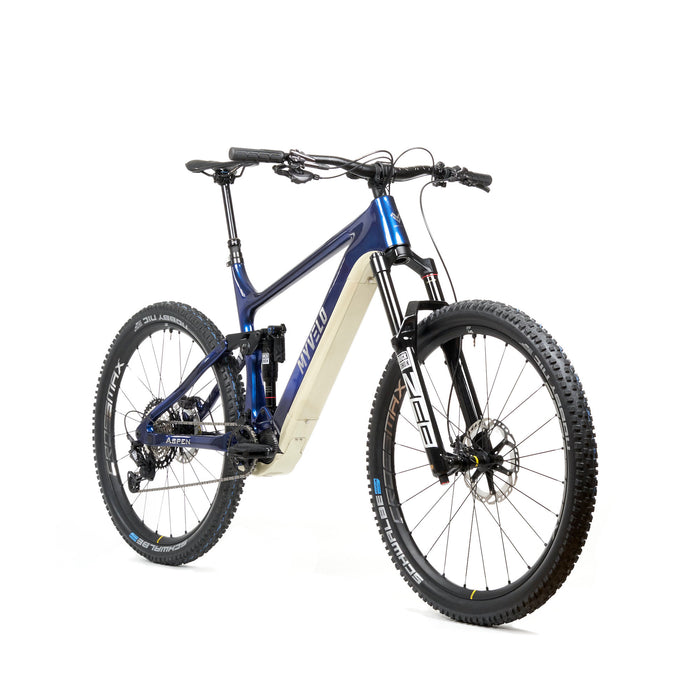
MYVELO ASPEN E-Fully MTB
incl. FREE shipping & free returns

Von Fabian Huber |
8 minutes read time

The calculation of electricity costs is based on four input values:
Conversion of battery capacity in kWh:
Calculating the number of full battery charges per year:
Calculation of annual electricity costs:
This method shows how to calculate the electricity costs for different input values. Depending on the electricity price and driving habits, the costs can vary greatly.
Energy consumption, replacement battery, wear and tear: What are the maintenance costs for e-bikes that e-bike buyers expect? As expected, the electric bike incurs further operating costs after purchase. To determine how high the maintenance costs are for an e-bike, it is important to note that some parts are subject to greater stress than on normal bikes due to the additional drive power.
The electricity for the e-bike battery is also expensive; you can calculate these costs with the e-bike electricity cost calculator. Faster than cycling, more environmentally friendly and often more practical than driving a car: for many people, electronic cycling has become an important part of their individual mobility. But what costs can you expect when maintaining an electric bike?
Whether it's a trekking bike , a mountain bike or an electric racing bike - there's buzzing and gliding everywhere. The triumph of e-bikes is very successful. In recent years they have become more and more popular and are now an essential part of every cycling scene. An electronic bike generally costs about twice as much as a conventional bike and of course also has higher running costs.
Charging a 500 Wh battery at a cost of 0.30 euros per kWh requires about 0.15 euros. This value occurs for each full charge cycle, regardless of whether it is fully reached or started by intermediate charges. Here, manufacturers indicate the maximum number of charge cycles for the battery.
Assuming 1,000 charging cycles, the electricity costs with the above values amount to 150 euros for the entire service life of the battery of an electric bicycle.
If the battery supplied no longer provides enough power, buying an e-bike battery will cost additional money. So the question is, how long can a battery with good performance last and how long will it work? As standard, today's lithium-ion batteries used in most electronic bicycle drive systems have up to 1,000 charge cycles.
The obvious factor in the cost of running an e-bike is energy consumption. After all, with average usage, the electronic bike should be charged once or twice a week .
If you set the electricity price at 0.30 euros per kilowatt hour, the maintenance costs for the e-bike or pedelec for charging the 500 Wh bicycle battery are around 15 cents. Modern chargers have a very high efficiency. Sometimes 95%, which means that charging losses can be neglected.

Modern technologies are often considered less durable and reliable than their predecessors and are often irreparable. This definitely does not apply to electric bikes. Almost all components work better and more comfortably today, and many of the bike's classic weaknesses have been eliminated.
However, wear and tear is still not a negligible factor. This is where electric bikes have disadvantages compared to conventional bikes. The costs do not only relate to the electricity and material costs - there are also maintenance costs in a specialist workshop. Changing the brake pads, for example, costs around 15 euros.
Maintenance costs vary greatly depending on how often you use the bike and how you treat it. We usually recommend an annual service check. Depending on the scope of the check, you can expect to pay between 50 and 150 euros. A new battery costs 400 - 1000 euros. A modern battery lasts around 100,000 kilometers. That means you can travel around the world about two and a half times without changing the battery.
An electric bicycle such as the Pedelec requires approximately 0.7 kilowatt hours (kWh) of electricity per 100 kilometers, i.e. 7 watt hours (Wh) per kilometer (one kilowatt hour is roughly equivalent to one washing machine cycle or seven hours of television).
Of course, this value varies greatly depending on the bike, riding situation, rider performance and weight. When riding uphill, more than 20 Wh / km are consumed. If you ride straight, the value is less than 10 W / km.
With the current electricity tariff in Germany, carbon dioxide (CO2) emissions are around 600 grams, i.e. one kilometer with an electric bike produces almost 6 grams of CO2. From an environmental point of view, however, it should be clear: an electric bike is only ecological if the battery is charged with certified green electricity.
The cost of a spare battery, which will need to be replaced sooner or later, should be added to the electricity costs. If we realistically assume that the battery lasts for about 700 charging cycles and costs about 700 euros, you will have to budget one euro for the subsequent costs of an electronic bike every time you charge it.
The only question is when new investments will be required. If the vehicle is used frequently and intensively, for example on the daily commute , this may be in just two or three years.
Frequent "discharging" shortens the battery life. Regular charging, on the other hand, is beneficial for the battery and does not reduce the number of charging cycles. A partial charge always corresponds only to the corresponding part of the charging process.
Theoretically, a battery can be half-charged 2000 times with 1000 charging cycles. With the e-bike electricity cost calculator, you can calculate the costs for partial charges just as easily.
An electric bike needs regular maintenance, also known as a bike inspection. This inspection is carried out in a specialist workshop according to the checklist developed jointly by several associations and clubs.
If you want to service your bike yourself, you can use the same list as a specialist workshop. A private bike inspection can be carried out correctly in many areas, but a visit to a bicycle mechanic is particularly advisable for components that are important for safety.
When should the inspection be carried out? After purchasing a new electric bike, the bike is inspected for the first time after 300 km or after 3-6 months. In your interest, the inspection should be carried out at least once a year.
Spring is a good time to start a new season with a service and a well-maintained bike. Anyone who rides all year round is well advised to have two small inspections per year.
A small bike inspection usually costs 20 to 25 euros. The price differs for racing bikes / MTBs and city bikes . A larger inspection costs between 40 and 50 euros.
A distinction is also made here as to whether it is a fully equipped bike or a racing bike / MTB . A full maintenance for an electronic bike costs between 50 and 60 euros. It also includes software checking and the implementation of updates.
In general, the cost of inspecting a bike should always be considered excluding materials. Small repairs that do not require new components will be included directly in the bill at a good bike shop.
Electric cars and electric bikes have one thing in common - they run on electricity. But this also means they need to be charged regularly and the battery will eventually need replacing. Then there's normal tire, chain and brake wear and the need for insurance... so there are many factors that go into the cost of ownership. Also remember to buy a good helmet to protect yourself as best you can.
Insurance is mandatory for S-Pedelecs and costs around 50 euros per year. Insurance is also useful for conventional electronic bicycles, especially against theft if you live in a densely populated urban area. You also pay 50 euros per year for this.
How much does wear and tear cost on e-bikes? Electronic bikes are reliable, but if there is a defect in the motor and electronics, it can quickly become expensive.
It could also be a display, for example, which then costs almost 200 euros - depending on the system - or it could be a special drive wheel and electric motor in a single speed . A new hub motor costs around 300 euros. The wear and tear on chains and sprockets is significantly higher with a mid-engine because the load is higher.
Of course, classic e-bike wear parts should also be replaced regularly. In addition to the sprockets and chains already mentioned, there are also brakes, cables and tires. Regular inspections will help you determine when action is required. Frequent riders can consider belt-driven bikes instead of a chain-driven bike, which are much quieter and more stable, but also more expensive.
All owners or potential owners of S-Pedelecs should pay attention to the additional costs. The electricity costs for S-Pedelecs can also be calculated using the e-bike electricity cost calculator. Thanks to the electric motor, these bikes can move at an enormous speed of 45 km/h, so you can ride much faster than with an electronic bike or a classic pedelec.
The legislator also takes this into account: For example, the S-Pedelec must have an insurance label and may not use bicycle paths or sidewalks, among other things.
In any case, it should be a third party insurance, which is cheap - around 50 euros per year. If you want to insure yourself in case of an emergency, you should prefer a fully comprehensive insurance. This is around 75-120 euros per year, depending on the cost of the bike and the insurer you choose.
In the end, the question arises: Does it make sense to buy an electric bike or even the more expensive S-Pedelec? Definitely, yes!
The conclusion regarding the maintenance costs of e-bikes is that electric bikes are still much cheaper to maintain and service than a car. Of course, you are doing something good for yourself and for Mother Nature.
Get advice from cycling enthusiasts
Comments
Leave a comment